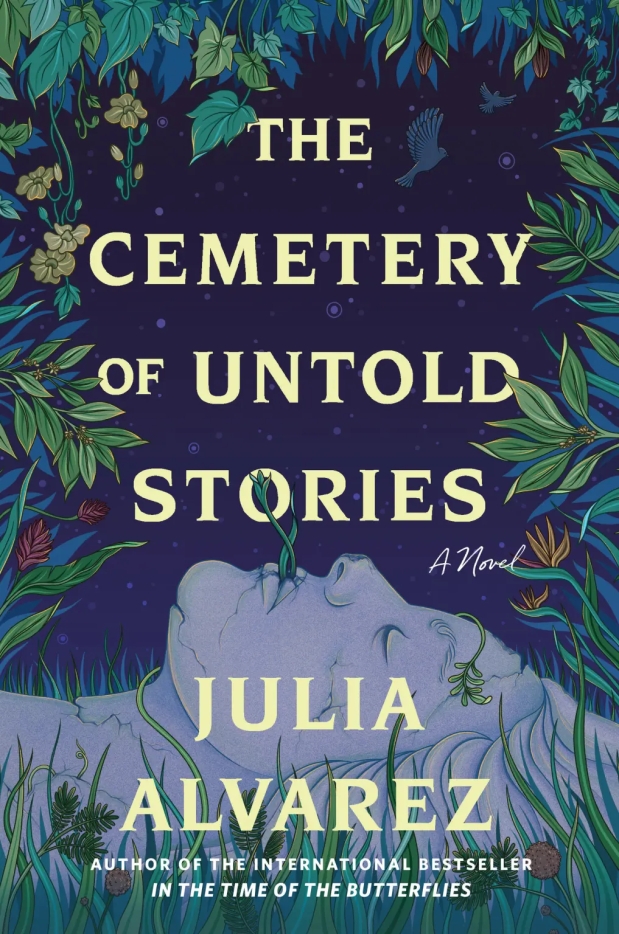“How does it feel being the elder that you yourself didn’t have?” asked moderator, Dr. Rebeca Hey-Colón, an assistant professor at Temple University.

This was one of the questions posed to Julia Alvarez on Thursday, April 4, 2024 at the Free Library of Philadelphia. She was there to read from her new novel The Cemetery of Untold Stories. Alvarez spent the entire evening comfortably in her role of elder, inspiring, offering advice on writing and storytelling, and on life. She discussed aspects of creativity and the writing process in addition to reading an excerpt from her novel.

I first heard of and met Julia Alvarez over 30 years when I had been studying in the Dominican Republic at the Catholic University in Santiago de los Caballeros. I attended a conference held in Santo Domingo on Caribbean Studies. What I remember was standing on the buffet line next to her, waiting to get our food, and talking about whether or not her poetry would be accepted by Dominicans on the island. Alvarez did not think it would be.
This was heartbreaking for me to hear, but it was a time when there was not a market yet for United States literature written in English or a mixture of Spanish and English by latino authors. It was considered exotic (and questionable according to some) for me to travel to the Dominican Republic to study abroad—Mexico and Spain were much more mainstream destinations. “Why are you going THERE?” was probably the least offensive. Dominicans were migrating to the United States and mainly lived in New York City, and back then they were referred to as “Dominican Yorks.” They had to adjust to a new reality in a northeast city in the USA, but if/when they returned to the Dominican Republic they were considered “suspect,” and “different” by those living on the island. This immigrant story of being neither from “here” nor “there” continues to repeat with every group that migrates.
In her talk on Thursday, Alvarez peppered her conversation with words and phrases in Spanish, and a good number of audience members understood, as there was much laughter at her jokes and an uplifting vibe to the entire event. Her down-to-earth candor and humility were well received. Philadelphia has a large Dominican American population, immigrant Mexican community, as well as the second largest Puerto Rican population on the continent (over 145,000 Puerto Ricans) behind New York City. However, the audience was a mix—people of all backgrounds, native languages, and ages, even some who had read her works in other languages besides Spanish and English were present and enthusiastically engaged.

I haven’t read The Cemetery of Untold Stories yet, but I’m looking forward to it. It’s about a woman writer who is retiring, and she wants to find some closure from the stories that haven’t been told but still live in her head. She moves to the Dominican Republic and creates a cemetery that is not of dead people but these stories. Without giving spoilers, it seems like something in the “magic realism” vein is going to happen, and that Alvarez draws from her own experience too. After all, she is now in her 70s and she thinks about aging and desired to create more mature characters that are in their twilight years. The stories in the writer’s head though, are not dead, but seem to have a life of their own, and they would live on beyond the author. Actually, this happens when a book is published or when a story is told and retold. It takes on a life of its own living in other people, continuing to influence, change realities, touching the next person who hears or reads it.
According to Alvarez, stories create communities, and the diaspora broadens the community. Both moderator Rebeca L. Hey-Colón and Alvarez mentioned the importance of the oral tradition in Latin American cultures. This is an intrinsic part of Alvarez’ life and her aesthetic. She told us that storytelling was always happening while growing up. Many people in her childhood didn’t read a lot of literature, but they sure could talk. When she was studying in a Creative Writing MFA, she realized that some of the techniques she was learning in classes, she already knew how to do–she had picked them up from listening to stories and following master storytellers in her family and community.
Another insightful idea which grew out of a reference to Haiti and the massacre of Haitians under dictator Trujillo, was that “the diaspora brings people together who might have been separated on the island or in their homeland.” Dominicans who migrated to the United States and on the island have joined with Haitians to form Borders of Light. Trujillo ordered the murder of Haitians at the border in 1937 and it was a horrific crime for which he was never punished and which created a distrust and hatred between Dominicans and Haitians. The class and race divisions that existed on the island, are at least blurred when they arrive in the United States, since they are all immigrants, and often starting from scratch, and facing the same challenges, and an organization like Border of Lights was established to make sure that the world knows what happened in 1937, and to join together to remember the victims.
Near the end of the evening, Alvarez stated, “We don’t own the stories” and that “each book is different” when asked about knowing when a book is finished. This seems to be instinctive in her case, although she did admit that sometimes a good editor would step in and determine where the ending should be. The final question from the audience requested advice for a young Dominican writer who was struggling to get his work out there. Julia Alvarez the elder recommend that you need to “find community” and don’t give up. You need to write and tell your stories because simply “that was what you were put here to do.”


































